Scaling Lean Book from Ash Maurya – My Top 5 Learnings
Rating, Summary, Author & a lot more
Pages Calculator:
Top 5 Keylearnings from Scaling Lean
The book Scaling Lean builds on the Business Canvas and the Lean Canvas. It provides practical instructions for checking business ideas and start-ups for their success. Here are my top 5 keylearnings:
1. There is no business without revenue. At the beginning of my start-up I mainly dealt with business cards, websites and SEO agencies. But we didn’t even have a customer yet. Unfortunately, we had to crush this business idea.
2. There are three phases in a start-up. Problem Solution Fit – Product Market Fit – Scale. Each phase requires a different direction for the company.
3. Establishing repeatability in a business model is a basic requirement for a scalable start-up.
4. It’s not about selling your product. It’s about getting your customers to use your product to solve their problem and make them happy.
5. Three things that really interest investors: 1. How big is the market. 2. How do you intend to make money. 3. How do you hold off copycats and competition?
 Who is Ash Maurya?
Who is Ash Maurya?
Ash Maurya is a two-time writer and founder. He further developed the Business Model Canvas and created the Lean Canvas tool. If you read his résumé you can rightly say that he loves start-ups. He is an advisor in countless young companies, regularly gives workshops in accelerators and has developed a system with which start-ups and business ideas can be analyzed for success at an early stage. As a business blogger, he is featured regularly in magazines such as Forbes, Fortune or Inc. Magazine.
The rest of the time he takes care of his own company LEANSTACK. This is a platform for young entrepreneurs. There you will find tons of blog articles, videos, tools and much more to help drive your business forward.
Applicability of what has been learned from Scaling Lean
The author has managed to combine a lot of new knowledge and create a new system from it. What exactly do I mean by that?
He has rethought proven tools such as the Business Model Canvas and combined them with ideas from the book Lean Start Up. He has transformed sprint techniques from IT into lean sprints and thus created a fast and effective system to test new features and ideas in a start-up. He has packed complex processes in business growth into simple phases.
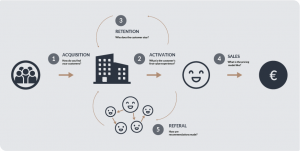
The Happy Customer Factory accompanies you while you read. This means a mental factory through which your customers walk. Every company can be put into this thought model.
Acquisition – You need acquisition in order to be able to lead customers into the factory.
Activation – Once the customer is in your factory, you have to fulfill your advertising promise.
Retention – The longer the customers stay in your “factory”, the greater the value must be for them. But to do this, the time they spend on your product has to be directly correlated to the value that your product creates for them.
Revenue – Measures all of the monetizable value that you capture from your customers.
Referral – Only if you generate really happy customers will they tell you about their experience and recommend you to others. But it can also go exactly the other way with negative word of mouth.
The book is written and designed in such a way that it is made for direct implementation of the content. If you are just starting your own start-up or company, it is the perfect reading to gather new impulses and motivation. There are many examples from other companies in the book. In these, the strategies and techniques in the book were tested and modified if necessary. So it’s more of a playbook than a pure non-fiction book.
Comprehensibility of the content from Scaling Lean
Thanks to the Happy Customer Factory, the content is presented in a very understandable manner. There are key take aways and tasks after each chapter. There are a lot of visualizations and graphics included. The contents are always shown using real examples and the author has built his own company with the contents of the book.
TIP: If your business English is not that good, I definitely recommend reading the German edition.
Scaling Lean explained in 500 Words
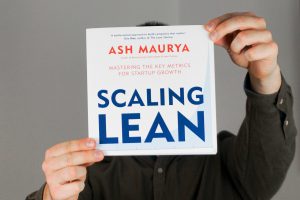
The book Scaling Lean is an advanced reading. I recommend books to you like Lean Start Up*, Engpasskonzentrierte Strategie*, OKR* & Scaling Up* having read before.
At the beginning of the book, Ash explains to Maurya his understanding of Lean.
GO LEAN
G = Goal: Define your goal in a functioning business model.
O = Observe and Orient: Learn to benchmark your key figures and better assess risk.
L = Lean, Leverage or Lift: Use Lean Sprints to quickly see success in the business model. Learn more about your bottleneck – leverage your bottleneck – strength the solution to the bottleneck.
E = Experiment: Run small experiments quickly to test your ideas
A = Analysis: All of your experiments must be closely tied to your goal / strategy.
N = Next Actions: The analysis specifies the next actions.
You will be guided through these 6 principles in the following chapters. For the Goal, he created a simple formula for each business model:
Created Value> Captured Value> = Cost (Value Delivery). Your created value must be greater for the customer than what he pays (captured value). And what he pays must be greater than or equal to your cost.
Rate traction as the most important KPI, not sales. What is traction?
Traction is linked to the previous key user actions. These past key user actions are the most important indicators for examining future growth.
Example: Starbucks has recognized that the time a customer spends in the store correlates with the sales per customer. So a key action was getting customers to spend more time in the store.
Traction is the one metric that matters most. Traction is the rate at which a business model captures monetizable value from its customers. A time traction goal is much more tangible than a sales goal.
In addition to traction, there are two essential key figures:
Throughput is traction
The more customers you can send through the “customer factory” in a faster time (without losing quality), the faster and bigger your company can become.
Customer throughput vs throughput
Customer throughput measures the rate at which you are creating customers. The throughput measures the rate at which you create monetizable value from your customers.
There are three phases in every start-up:
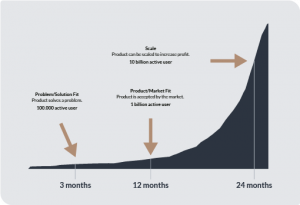
Problem Solution Fit
The overall goal of this phase is to test that your idea is a significant enough problem to be resolved.
You test this phase with an “offer”. Before you built the product or take care of financing. An offer consists of UVP, DEMO & PRICING
Product Market Fit
The overall goal of this phase is to demonstrate that your
Small-scale business model works
Scale
This phase is not about driving your product to perfection, but rather finding the right levers for growth in order to realize the full potential of the business model.
Identify and resolve bottlenecks
At each point in these phases you will encounter different bottlenecks. These can be external and internal factors.
| Extern | Internal physical | Interne Political |
|---|---|---|
| Market | Time | Mindset |
| Laws | Money | Methods |
| Pandemics | Employees | Measurements |
| etc. | Equipment |
Once you run into a bottleneck, follow these 5 steps:
- Identify the bottleneck
- Recycle the bottleneck
- Everything else is subordinate
- Leverage the bottleneck
- Start again at step 1
The last part of the book is all about experiments and analyzes. Use lean sprints to do this. These are 2 – 4 week periods in which you test your strategy. You hypothesize what you hope for from the experiment, what you have learned from it, and what the next steps are now.
You always pack all of this into a Lean Sprint and can carry out up to 25 experiments per year. At this pace, you can instantly validate new ideas and strategies and accelerate your growth.
Why you should read Scaling Lean when you are doing the Power MBA:

Ash Maurya is one of the mentors for the Power MBA. You will see him in some of the videos in the 3 module. It deals with the topic of Testing Business Ideas & Lean Start Up. There you can see lessons from him and Eric Ries, the author of Lean Start Up. It is very inspiring and fascinating to learn from these two people. The lessons with Ash Maurya are mainly about testing hypotheses in your Lean Canvas. The lessons cover the following questions:
- How do you set up experiments?
- Which should you do first?
- How do you interpret the results?
- What are the risks to be aware of?
- and much more.
In order to be optimally prepared for these lessons, I recommend his books to you Running Lean* & Scaling Lean*
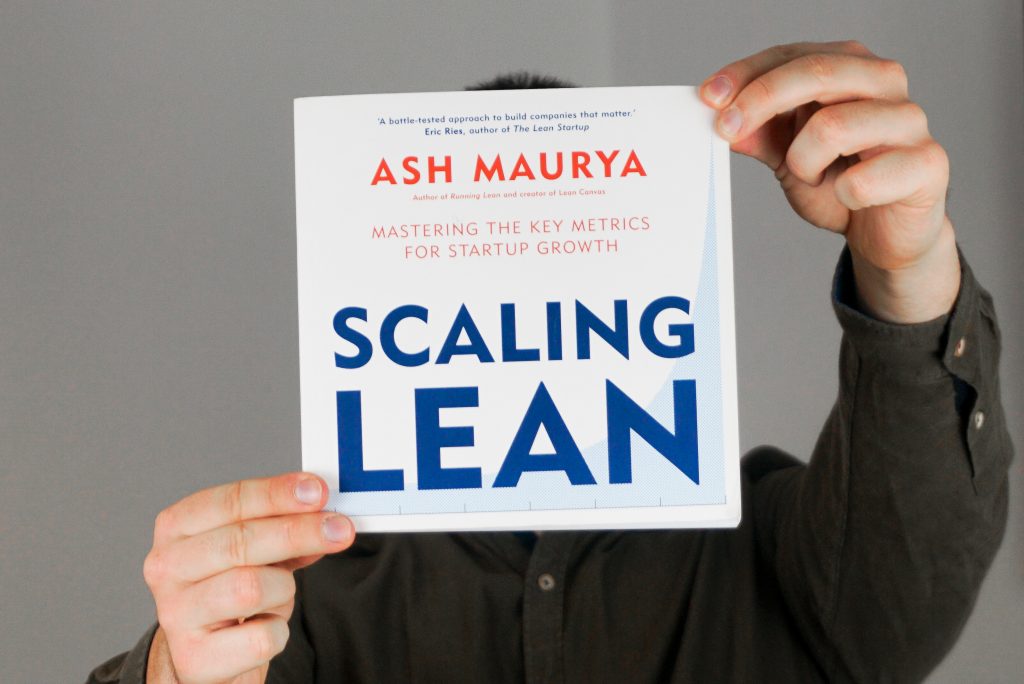
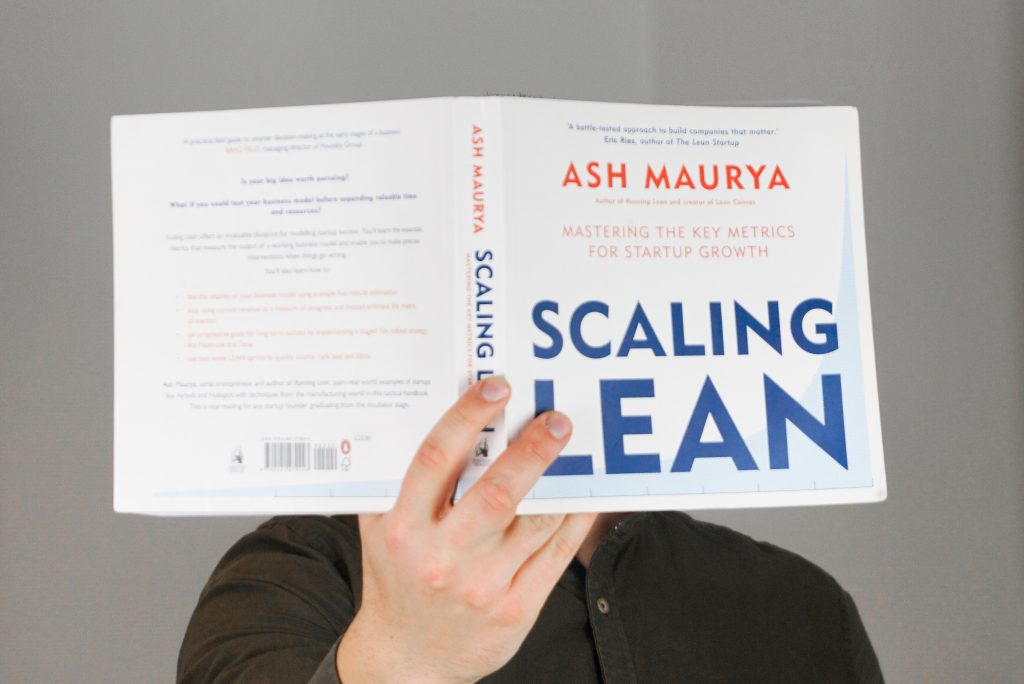

 Who is Ash Maurya?
Who is Ash Maurya?